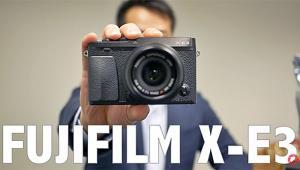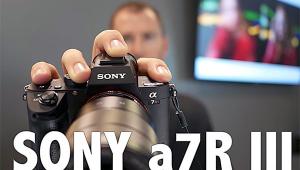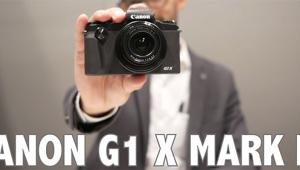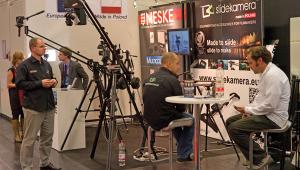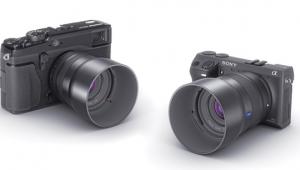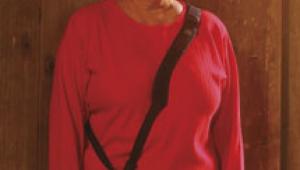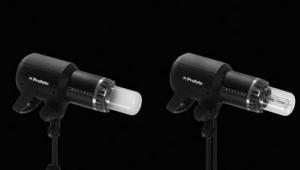Best Of Show: Our Reporters’ Top Picks Page 2
Konica Minolta's DiMAGE Scan Elite 5400 II
There's always something of interest at a PMA trade show, and the beauty
of it is, you never know what to expect around the next corner. But when Anna
Doi, Product Manager, Film Scanners and Software, enthusiastically rushed over
to show me something new at Konica Minolta, I eagerly followed her, certain
that there would be something to whet my appetite. And I was not disappointed.
What she unveiled was the latest-generation DiMAGE film scanner, the Scan Elite
5400 II. What immediately caught my eye was the sleek, sexy styling of the scanner,
with its creamy white texture. Even the buttons on the face of this 5400dpi
35mm slide and negative scanner were très chic. But of course a scanner
is more than looks alone.

There was good reason for Doi's enthusiasm: She helped design this device.
Her theme for the new scanner is: "Pro quality at a consumer price."
This was her rationale when designing the scanner: "Mid-to-high-end scanner
users are looking for excellent image quality, productivity, and ease of use.
The DiMAGE Scan Elite 5400 II includes a new Film Expert Algorithm, which is
a synergy technology from the Konica Minolta integration, for excellent image
quality and faithful color reproduction. This easy to use scanner also features
super-fast 25 seconds-per-frame speed (sans enhancements, in Windows). Dedicated
driver software provides added functions to respond to versatile workflow and
preferences of experienced photographers and hobbyists alike."
This new film scanner supports USB 2.0 and features 16-bit A/D conversion, a
dynamic range of 4.8, Digital ICE4, and Konica Minolta's Pixel Polish
for automatic high-quality image correction, along with batch scanning utilities.
Multi-sampling is also available. And all this and more for $599 (street)--that
is simply incredible! Hence my choice of the DiMAGE Scan Elite 5400 II as Best
of Show 2005.
--Jack Neubart
Corel--Exceptional Software At Affordable Prices
Corel Corporation is my pick for Best of Show. Through a combination of partnerships
and acquisitions Corel is bringing today's photographers exceptional software
at reasonable prices. For those of us who pursue artistic markets, the amazing
Painter IX can be used to modify photographs in ways that plug-in filter users
can only dream of. And Corel's free online training videos for Painter
are a great way for new users to quickly come up to speed.
For those who shoot raw files, Corel chose PMA to announce that RawShooter Essentials
2005 would be a free download from their website (www.corel.com/downloads).
Developed by Pixmantic, RawShooter offers a quick way to view, prioritize, and
process camera raw files. Its interface makes image adjustments such as color
and exposure corrections, sharpening, and noise suppression fast and easy. Corel's
acquisition of Jasc in October of last year has added new energy to Version
9 of Paint Shop Pro, an affordable and powerful alternative to Photoshop. Finally,
Corel's support of Kai's Power Tools, the groundbreaking filters
that pushed the limits of manipulation, and Corel's professional-grade
masking program KnockOut 2 round out a stable of excellent tools for creating
great pictures.
--Chris Maher
Wi-Pics Wireless Image Transfer
A few weeks ago, I received an e-mail with fluffy, cold, snow-drenched photographs
attached. The images had been taken and transmitted via a cell phone from Reno
to my studio in Georgia. The immediacy was great. The monitor quality, adequate.
The effect, priceless. While wireless camera phones are becoming increasingly
popular (150-million devices expected to be shipped this year) for consumers,
upscale technology designed for professional photographers to shoot images on
location while wirelessly transmitting those images to a server for immediate
editing, viewing, and distribution to their clients is becoming more readily
available.
Wi-Pics, developed by Dice America Corporation, is designed to work with all
digital cameras with a CompactFlash port. The card is replaced with a like-sized
CIC (Camera Interface Card), which is attached via cable to a device on the
photographer's belt. Images can be transmitted to an access point as far
as 100 yards away depending on the power and speed of the device being used
and the terrain it is being used in. Depending on configuration, as many as
40GB of data can be stored on an internal hard disk or a supplemental CompactFlash
II card. Image transmission speed also relies on a variety of factors, and the
Wi-Pics device and the unit automatically stop and resume transmission as the
unit travels in and out of range of the "access point."
The Wi-Pics device utilizes the three dominant 802.11 standards for wireless
LAN (Local Area Network) technology--802.11a, 802.11b, and 802.11g, which
operate in either 2.4GHz or 5.7GHz radio band frequencies. Transmission speeds
range between 11 and 54Mb/s (mega bits per second) with capabilities as fast
as 108 bits per second, using certain manufacturer's proprietary extensions.
For event photographers who spend a lot of time rushing between the shooting
site to the sales area to switch cards for downloading and editing images, a
device of this nature sounds like a no-brainer. We have found that during most
events, the faster we can make images available for viewing the better the sales.
In this market immediacy drives impulse buying. Using a Wi-Pics device, I would
be able to set up an "access point," such as an omnidirectional
antenna on the roof of my car and instantly transmit images back to a laptop
powered by a 120v inverter and my cigarette lighter. Target applications for
this device range from very small businesses to large operations with multiple
cameras and servers, such as the media, sports, schools, studios, and cruise
ships.
Dice America is not the only company pushing the envelope of wireless image
transmission. On the professional level both Nikon and Canon recently introduced
cameras with WiFi capabilities. Canon's EOS-1Ds Mark II is compatible
with the new Wireless File Transmitter WFT-E1A and Nikon's D2X can provide
full wireless remote camera control and transmission with its newly introduced
WT-2A WiFi transmitter. All in all, that adds up to the wireless revolution
being my pick for Best of Show.
--Ingrid S. Krampe
Epson's UltraChrome K3 Printers
While there were many products that deserve plaudits for Best of Show my choice
is one that just might change the way black and white photographers regard ink
jet printing. Well, it's actually more than one, all using a unique ink
set and printer/driver that might finally address some of the problems that
face monochrome photographers. While in truth I haven't had the opportunity
to test these printers and ink set, at least as we go to press, we will have
reports on it in a future issue of Shutterbug. I got a sneak peek at these printers
during the show, with the public announcement due when this issue hits the newsstands.
The ink sets and drivers are in a new class of printers from Epson, the R2400,
4800, 7800, and 9800. All four printers will work with a newly formulated pigment
ink set known as Epson UltraChrome K3 that promises fade resistance up to 200
years (!) for both black and white and color prints. Indeed, the prediction
is that when used on Epson UltraSmooth Fine Art Paper under professional UV
display conditions black and white prints may well last up to 300 years, or
so says Henry Wilhelm's testing (www.wilhelm-research.com).

These printers using the K3 inks will now have a new eight-color pigment ink
set, including photo or matte black, a light black and light, light black, plus
cyan, magenta, yellow, light cyan, and light magenta inks. The claim is that
these pigment inks will significantly improve the printer's gray balance
while eliminating color casts and dramatically reducing metamerism and bronzing.
But the big news here is what Epson dubs their new "advanced black and
white print mode." This incorporates a unique driver for using the three-level
black system with a claim that it has no color crossover or color cast. The
setup is built into the driver and actually has one choosing it over the "no
color management" option that most Photoshop users have come to know and
use. While Epson has yet to build this into a preview mode, the developers assure
us that this will open up new potential for black and white printers unheard
of with pigment ink sets before.
The 13" R2400 will sell for $849; the 17" Pro 4800 will go for $1995;
and the Pro 7800, a 24" printer, should sell for $2995. The massive 44"
Pro 9800 will sell for $4995. The R2400 printer will retire the venerable 2200.
It looks like Epson has realized that black and white printing is just as important
to us all as is color printing, and their work here bodes well for all who work
in the monochrome realm.
--George Schaub
Ilford Is Back!
The long-rumored management buyout succeeded just hours before PMA opened. The
old name was Ilford Imaging UK Ltd. The new name is Ilford Photo. The king is
dead; long live the king.
For me this was the best news at PMA: unquestionably Best of Show. The 125-year-old
company had gone into receivership in August 2004, and although they were at
photokina their future was uncertain. They continued to trade, but there were
constant differences of opinion with the receivers, who understandably wanted
to concentrate on the most profitable lines, and the old Ilford hands who wanted
to keep the full line up and running.
As a result, some retailers experienced difficulty getting all the supplies
they needed and a few products temporarily disappeared. Of course this disappearance
may have had more to do with panic buying by photographers as with problems
in production. By the time you read this, the worst of these problems should
be over. With any luck, even the powder chemicals will be coming back on stream:
Perceptol, ID-11, Microphen.
The head of marketing Howard Hopwood said, "The team will be focusing
on our black and white business." Ilford has for many years been at the
top of the monochrome market, and they are now in a position to grow even further.
They are even looking at the possibility of new products, or re-introducing
old ones: I keep pushing them for FP4 glass plates, and they said they wouldn't
rule it out. It doesn't get much better than that!
For anyone who loves black and white photography, and the craft of real printing,
this has to be the best news possible. Even Ilford's competitors were
pleased. Many of them stopped by the booth to congratulate the new team. And,
of course, the timing of the announcement couldn't have been better, with
PMA opening two days later and the major English show, Focus on Imaging, opening
the following week. This meant that the word could be spread far and wide--fast.
What can you do? Go out and buy Ilford films and papers (and chemicals). If
your dealer tells you they aren't available, tell them the good news.
If they still won't order them, change dealers! We are all in this together,
and anyone who can't be bothered to help the whole business shouldn't
be trusted with any of it.
--Frances E. Schultz
Manufacturers/Distributors' addresses can be found on page 176.
- Log in or register to post comments
